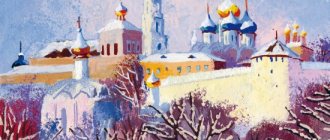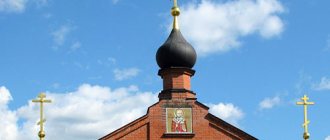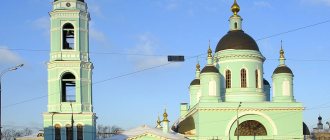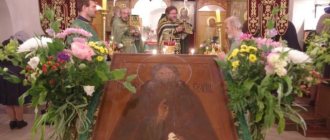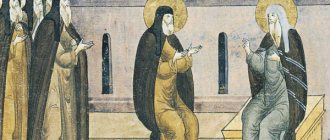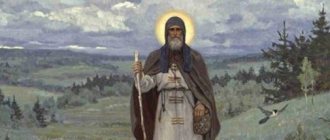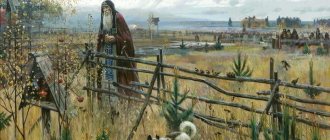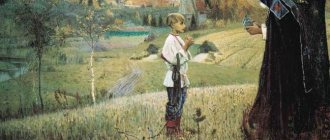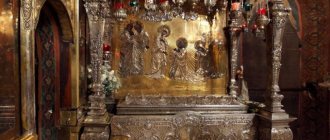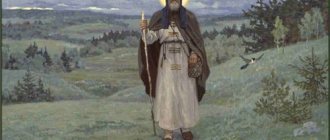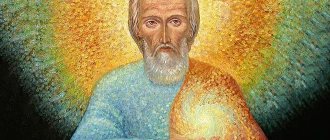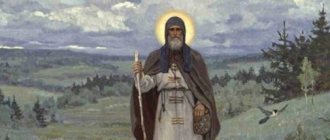Venerable Sylvester of Obnorsky, Poshekhonsky
The Monk Sylvester of Obnor lived in the 14th century and was a contemporary of St. Alexy, Metropolitan of Moscow, and one of the disciples of the Monk Sergius of Radonezh. A lengthy biography of the Monk Sylvester has not survived. It is known that the love of prayerful solitude lived in him from a young age. Having received the blessing of his mentor, the abbot of the Trinity Monastery, St. Sergius of Radonezh, the monk Sylvester went to look for a deserted place to remain in silence. On the bank of the Obnora River, covered with a dense forest, about 20 kilometers from the former city of Lyubim in the Yaroslavl land, in a remote, deserted desert, the monk erected a cross. Having built a small cell, the holy hermit began to spend days and nights in tireless prayer and strict fasting. A legend has been preserved that one day, while going to the river for water, the monk received a revelation that the desert he had chosen for ascetic labors would become famous and would gather many monks.
After some time, the solitude of the Monk Sylvester was discovered by residents of the surrounding villages, and people began to come to the hermit for advice and blessings, seeking spiritual guidance. The Monk Sylvester greeted everyone with love and blessed everyone who wanted to strive in joint labors to establish a separate cell. When the number of desert dwellers increased noticeably, the Monk Sylvester decided to found a temple and a monastery in this place. He received a blessing for this, as well as an antimension for the temple, from St. Alexis, Metropolitan of Moscow († 1378). The Monk Sylvester became the first abbot of this monastery on the Obnor River, which was later glorified by the Monks Pavel Obnorsky and Sergius Nuromsky with their spiritual exploits. The wooden church in the monastery was consecrated in honor of the Resurrection of Christ, which is why the monastery itself began to be called Resurrection. As abbot, the Monk Sylvester showed the brethren a constant example of prayerful feat and tireless work. The love of silence still lived in the heart of the ascetic. From time to time he left the monastery and went deep into the forest for solitary prayer. Here the Monk Sylvester personally dug four wells (one of which was known and revered even in the last century).
The desire to learn from the instructions of the wise old man forced the people to come to the place of his hermitage. The Monk Sylvester, without refusing anyone, came out of the shelter, blessed the pilgrims and had long conversations with them. The place where the monk retired, during his lifetime, received the name of a “reserved” grove, which local residents treated reverently, from generation to generation passing on the order of the holy elder not to cut down trees in it. In the depths of this grove, the monk himself dug three wells, and the fourth - on the mountainside near the Obnora River.
In 1645, the builder of the Resurrection Monastery, Hieromonk Job, neglected the miracle worker’s commandment and decided to cut down the grove. For this he was punished with blindness, from which he was healed at the tomb of Sylvester. From that time until now, no one dares to cut down a tree in the reserved grove. Despite the fact that there are few centuries-old trees there; time destroys them.
When the saint fell into a dying illness, the brethren, who grieved when he went into solitude, grieved all the more for the upcoming death of the saint. “Do not grieve about this, my beloved brothers,” the monk told them in consolation, “everything is the will of God. Keep the commandments of the Lord and do not be afraid to suffer troubles in this life in order to receive a reward in heaven. If I have boldness with God and my work is pleasing to Him, then this holy place will not become scarce even after my departure. Pray only to the Lord God and His Most Pure Mother to free you from the temptations of the evil one.” The monk died on April 25 and was buried to the right of the wooden Church of the Resurrection.
There is a well-known icon of the 17th century, on which St. Sylvester is depicted holding a scroll in his hand; The scroll contains part of the text of his will, which has thus come down to us.
Soon after the death of the saint, a chapel was built at the site of his spiritual conversations, around which religious processions were held annually on the day of remembrance of the holy ascetic. The burial place of the saint was especially revered, since miraculous healings took place from his tomb. Like other northern monasteries, the Resurrection Monastery was repeatedly destroyed: in 1538 during the invasion of the Kazan Tatars, in 1612 by Polish invaders. By 1647, the destroyed monastery was restored. In 1656, with the blessing of Patriarch Nikon, instead of a wooden chapel over the tomb of St. Sylvester, a temple was built in honor of the Intercession of the Most Holy Theotokos. In 1764, the monastery was abolished, and its cathedral church was turned into a parish church. In 1821, Archbishop Filaret of Yaroslavl (later Metropolitan of Moscow) gave a blessed charter for the construction of a stone Resurrection Church, which was completed in 1825, instead of the wooden Church of the Intercession. In one of the aisles of the Church of the Resurrection, in a bronze, silver-plated tomb, the found incorruptible relics of the Monk Sylvester were installed. In 1860, the Monk Sylvester again reminded of himself with several miraculous signs, a description of which was placed in the Yaroslavl and Vologda diocesan bulletins for 1860–1870.
See also: “ Memory of our venerable father Sylvester of Obnor” as presented by St. Demetrius of Rostov.
Life of St. Sylvester of Obnor
Life of St. Sylvester of Obnor
On May 8, the Church celebrates the prayerful memory of St. Sylvester of Obnor, whose short life we have included below.
Sylvester (14th century) was tonsured a monk by the Monk Sergius of Radonezh and first asceticised in his monastery, and then, having received a blessing for the hermitage, he retired to the borders of Yaroslavl, to the Obnora River, and having built himself a wretched cell in a dense forest, he devoted himself to unceasing prayer, courageously enduring all sorrows and needs. He ate tree bark and roots, and at first, without bread, he became so weak that he fell exhausted to the ground. But one day an angel of the Lord appeared to him in the form of a wonderful husband, touched Sylvester, and from then on he could already endure hunger.
The hermit Sylvester spent many years in complete solitude. But over time, by God’s will, the inhabitants of the surrounding villages learned about him and began to often visit the saint, bringing him bread, and from him they received saving instructions and advice. Some of them, wanting to asceticize under the guidance of the venerable elder, began to build their cells near him. This is how a new monastery arose, where Sylvester was ordained abbot.
After this, the brethren of the Obnorsky monastery began to multiply, and the saint sometimes had to retire to prayer in the forest, in a place that was later called the “reserved grove,” because the Monk Sylvester forbade cutting down trees there. When, many years after the death of the saint, a certain hieromonk Job ordered this grove to be cut down, the Lord severely punished him: Job became blind, and his sight returned only when he repented and promised to act not according to his own will, but in consultation with the brethren of the monastery.
Finally, the Monk Sylvester grew old and fell into a dying disease. Then the monks gathered around his bed and cried that they would lose their wise mentor and warm prayer book, fearing that after the death of the abbot the monastery would fall into decay. But the saint consoled them with the words: “Brothers, everything is the will of God. Keep the commandments of the Lord and do not be afraid to suffer troubles in this life in order to receive a reward in heaven. If I have boldness with God, then this holy place will not become scarce even after my departure.”
The Obnorsky monastery, founded by the Monk Sylvester, existed for more than four hundred years, and from the shrine with the relics of the saint many miracles were performed to the glory of the One God in the Trinity, the Father, the Son, and the Holy Spirit. Amen.
Reverend Father Sylvester, pray to God for us!
<< To the main page Lives of the Saints - complete collection >>
Prayer to the Hieromartyr Sylvester
“O wonderful servant of Christ, Hieromartyr Sylvester! With tenderness we bow our knees before your honest, celibate relics (in your holy image), we praise, glorify and magnify the God who glorified you, unworthy of us who has given you your intercessor and intercessor. You stand before him from the faces of the new martyrs of Russia and all the Heavenly Powers. Pray to the Lord to establish in the holy land of Russia the living spirit of Orthodox faith and piety, and to instill in the lands of Siberia a flaming love for the faith of the fatherland; Most of all, He will protect us with His omnipotent hand from schismatic false teachings and heresies. May he give people the spirit of repentance in apostasy and serving the vanities of this world; He gives us all the spirit of humility, meekness and obedience. May He gird us with His grace and strengthen us in the battle for our salvation. To Him belongs all glory, honor and worship to the Father and the Son and the Holy Spirit, now and ever and unto ages of ages. Amen."
The article by Yaroslavl historian Svetlana Chernetsova examines some aspects of the tradition of venerating trees in the context of the spiritual and historical development of the rural district of the Upper Volga region. The study covers the period from the 14th to the 20th centuries. n. e.
It is based on some little-known documents of the second half of the 19th - early 20th centuries. and previously unpublished ethnographic data collected by the author during field research in the vicinity of the village. Voskresenskoye, Lyubimsky district, Yaroslavl region.
Saint Sylvester of Obnor
Plant cults and their transformation in the traditional culture of the population of the Yaroslavl region have been studied much less than similar phenomena among the Mordovians, Udmurts, Mari and some other Finno-Ugric peoples. Reserved groves, functioning as sacred loci, are currently known in the neighboring Vologda region. But for a long time it was believed that by the twentieth century. on the territory of the Yaroslavl Volga region, none of the “sacred” groves have survived.
Resurrection Church
The article describes in detail a unique sacred village complex that has survived to this day, directly connected with the life of the locally revered saint - Sylvester of Obnor. The complex of objects of his spiritual practice included several natural objects, which later became the subject of veneration by local residents.
The cult of the tree was an integral part of the multifaceted traditional culture of the population of the Upper Volga region. Until the beginning of the 20th century. some of its elements were still widely preserved in the cultural traditions of the region. One of the forms of manifestation of the cult is the veneration of lonely trees. The key feature by which a tree could theoretically acquire sacred status was the presence of a special ring-shaped hole, formed as a result of the fusion of branches or manifested in the form of exposed tree roots. But even in the absence of external distinctive features, trees associated with some significant events could become objects of sacralization: boundary indicators, trees that survived a lightning strike, “burnt” trees, “dead” trees, etc.
Steps to the source on the banks of Obnora
Another important component of the cult was the veneration of holy groves. In the Yaroslavl province, the northern counties - Poshekhonsky, Danilovsky and Lyubimsky - stood out in this regard [11]. The special geographical remoteness of these regions contributed to the long-term preservation of the remnants of pagan beliefs and original forms of popular Orthodoxy.
It is practically impossible to reconstruct the tree cult on the basis of currently available materials. Partly because the information that interests us, reflected in pre-revolutionary literature, is extremely brief and only mentions individual objects. Thus, it is known that in the second half of the 19th century. in a number of settlements of the Yaroslavl province, several “holy” trees and groves still grew, in relation to which some elements of rituals were recorded, but most of these places have not survived to this day [10].
Holy spring
In this regard, careful recording and study of the few remaining objects seems to us very important for understanding the phenomenon of the cult of the tree in the context of the spiritual and historical development of the rural district of the Upper Volga region.
The sacred locus, mentioned in hagiographic literature under the name “reserved grove,” was located between the village. Voskresenskoye-on-Obnor and the village of Froltsevo in Lyubimsky district of Yaroslavl province.
Beginning of the grove
Currently, it refers to a large forest area starting from the north-east wall of the temple in honor of the Resurrection of Christ in the village. Voskresenskoye and stretching along the right bank of the river. Obnory to the middle of the modern village. Froltsevo. The total length of the massif is about 600-700 meters with a width of 200-250 meters. The grove mainly consists of coniferous (spruce, pine) and birch forests. The age of the trees does not exceed 100-150 years.
Field research allows us to draw an unambiguous conclusion that in this place there is a sacred complex consisting of a number of church, archaeological and natural objects interconnected in ritual and folklore [7].
Path to the grove
In the recent past, these objects were systematically used in the religious practice of the local population and continue to be used in fragments at the present time. In the form in which the sacred complex has been preserved to this day, it consists of the “reserved grove” itself, a temple in the name of the Resurrection of Christ, a chapel on a spring, a holy spring and a worship cross. In the middle of the 19th century. this complex included a much larger number of revered objects: three wooden churches of the Resurrection parable (Pokrovskaya, Voskresenskaya, Sretinskaya), a reserved grove, a cemetery, three wells in the grove, dug by Sylvester himself, a holy spring on the edge of the grove, a chapel in the field (at the end " Sylvester's path") and a chapel on a spring.
Old spruce
With a high degree of certainty, we can assume that the complex also included two old, fairly swollen mounds - “Bolshoy” and “Small”, which are located on the outskirts of the village of Froltsevo [6]. In addition, the “Sylvester’s path” was most closely connected with the complex, marking the end of the road from the grove to the field to the place where Sylvester talked with visitors [1, p. 41]. There was an old legend about her here, passed from generation to generation, that this was the very path along which the ascetic went out to the people. At the turn of the 19th and 20th centuries. the trail practically ceased to exist, since it was built up with houses of an overgrown village. Apparently, this fact is directly related to the dismantling of the old chapel in 1820 and the construction of a new one in a different place. Thus, we can formulate the assumption that the ancient “Silverstra Trail”, as a specially distinguished object, continued to exist since the 80s. XIV century (date of death of the ascetic - 1379) until the middle of the 19th century, since by the beginning of the 20th century. it was already built up with houses. It cannot be ruled out that “Snail’s Trail” also had some relation to the sacred organization of space [1, p. 10].
Obnora coast
The protected grove of Sylvester Obnorsky is located almost on the very border of the Yaroslavl and Vologda regions, in which the so-called bushes are known - sacred groves growing in the basin of the Kokshenga and Sukhona rivers [5].
When compared with the description of Vologda groves - “bushes” - many analogies are revealed with the grove in the village. Voskresenskoye: they are also located on a hill, clearly visible from afar, they also had a ban on cutting trees and other similarities.
Sacralization of the forest in the region of the village. Voskresenskoe is directly connected with the activities of the Monk Sylvester of Obnor. It is believed that in the place where the village is now located. Voskresenskoe, he built the first dugout cell, around which after some time the cells of his followers appeared. Later, but during Sylvester’s lifetime, a monastery was founded here. The hagiography of the ascetic tells that the monk was burdened by his broken solitude and at the end of his life he retired to live in a dense forest (grove), in which he forbade cutting down trees, making noise and disturbing his solitude. In the description of the icon of Sylvester, which in the 19th century. was in the Church of the Nativity of the Blessed Virgin Mary (Old Simonovo, Moscow), it was noted that the icon depicted the very area “...through which he walked to his reserved grove,” and the fact that Sylvester himself dug wells in the grove was mentioned night time [9].
Sylvester's Grove
In this case, we are obviously dealing with a certain retelling of a lost source - the handwritten “General Menaion”, kept in the Church of the Resurrection and destroyed in a fire in Chagin’s house at the end of the 18th century. [1, p. 5]. Local residents treated the grove with reverence, passing on from generation to generation the order of the holy elder not to cut down trees in it. In 1645, the builder of the Resurrection Monastery, Hieromonk Job, neglected the miracle worker’s commandment and ordered the grove to be cut down, for which he was punished with blindness [1, p. 13]. Apparently, this incident was of great instructive significance, since until 1856 the grove stood almost untouched in its original form and was “. so dense that it was difficult to pass through it” [1, p. 41].
After the death of Sylvester, in the place where the ascetic left the grove for spiritual conversations with parishioners, the first wooden chapel was built, crowning the end of the “Sylvester path”. In Voskresensky, for a long time, a wide path was preserved, leading from the grove to the field to the chapel. Every year on the day of remembrance of the holy ascetic, religious processions were held to this chapel. It is known that in 1864 the chapel was seriously updated and moved to another location [1, p. 42]. Now a worship cross has been installed in its place. Another chapel was installed in 1861 on the edge of the grove, right on the path in the ravine leading to the holy spring. In addition to this most popular and visited holy spring, in the depths of the “protected grove” there were three more wells dug by the monk with his own hands. They are by the middle of the 19th century. came to complete desolation, although they were still occasionally visited by pilgrims [4].
Key in the center of the grove
By 1825, in Voskresensky and its environs, except for Sylvester’s wells, there was not a single ancient authentic religious building associated with the memory of the saint. Apparently, the events of the first half of the 19th century. contributed greatly to the decline in the sacred status of the place. First of all, this was facilitated by the fact that during the construction of the stone Resurrection Cathedral (in 1825) and the demolition of the wooden Church of the Intercession (in 1822), the external passage to the shrine of the ascetic was lost forever. To a certain “sacred collapse” of the mid-19th century. directly indicates the more than modest income of the entire Resurrection parable, which in the period from 1822 to 1857 amounted to no more than 200 rubles a year from all three churches [1, p. 33]. But in 1856 in the village. In Voskresensk, an event occurred that apparently gave a powerful impetus to the restoration and further development of the entire sacred complex. The fact is that a strong hurricane in 1856 deprived the grove of “more than half of its mature trees” [1, p. 41]. State-owned peasants begin to use fallen trees for domestic purposes. It cannot be ruled out that it was precisely this circumstance - the gradual decrease in the special reverent attitude towards the grove - that became the background to the phenomenon of the miracle of 1860 [8, p. 4-510], after which the parable’s income sharply increases from 200 to 1500 thousand rubles per year [1, p. 33].
Great efforts were made to canonize Sylvester of Obnor at the end of the 19th century. undertaken by the prominent church historian, professor and rector of the Moscow Theological Academy S.K. Smirnov [8]. He compiled a service to the saint, described his life, and published a book. But, as follows from the correspondence of Archbishop Ionofan of Yaroslavl and Rostov with S.K. Smirnov, to send a service to Sylvester of Obnorsky in the village. Resurrection was not allowed by the Holy Synod, since he was not canonized [3]. This decision put both Jonathan himself and the Obnor priests in great difficulty, who “. Until now, they have performed services to the venerable one” [3, p. 548]. The reason for the refusal was the lack of opportunity to open and examine the relics of Sylvester.
During the Soviet period of the twentieth century. Due to the organization of the activities of the local timber industry enterprise here, the grove lost almost all its old trees. In the 50-60s. XX century this part of the river bank Obnory was already used as an open-air logging warehouse. During the autumn-winter, logs prepared for rafting were brought here from all over the area, and in the spring, immediately after the ice drift, they crashed into the river. Local residents born in the late 40s. they say: “...we have already found only young growth and healthy pine stumps. But the stumps were three times thick” (informant P.K. Maltsev, born in 1948, native of the village of Voskresenskoye). One of the informants remembers that as a child, her grandmother took her to a large stump on which a small icon was mounted (informant A.V. Menshikova, born in 1949, native of the village of Voskresenskoye). She remembers half-decayed rags and ribbons on the branches of some trees. Residents of the surrounding villages claim that “... this area is not subject to any reptiles. We have no snakes or snakes here. Here we Love - how far away?! It's full there, but not here at all. It was Sylvester who gave them (the snakes - S. Ch.) a covenant..." (informant - A. I. Antonenko, born in 1932; native of the village of Froltsevo).
Residents of the village Froltsevo, s. Voskresensky, Anashkino village, Gubino, the general tradition of wide festivities in the grove in the first ten days of May is still preserved. Before the revolution, the festivities were directly associated with Sylvester's Memorial Day and were held on May 8, that is, April 25 according to Art. style [1, p. 25]. After the Great Patriotic War, the tradition of holding a mass celebration in the grove shifted by one day. The celebrations took place on May 9 and were formally explained by the celebration of Victory Day. In Soviet pre-war times, May 1 was celebrated in the grove in exactly the same way. Today, the holiday is still celebrated on May 8th. On this day, all the residents of the surrounding villages went to the grove and set up a large communal table right on the grass with the inevitable drinks, generous food, songs and dances. In most cases, pancakes and boiled eggs were always present on the improvised tables. The use of these products in a joint meal in the grove is a very archaic element of the ritual of “feeding” the tree, that is, in fact, a joint ritual meal in which typical funeral food is involved [2]. The average number of participants in such feasts was 50-70 people, but there were many more.
It is known that the Vologda sacred groves-“bushes” actively functioned as revered objects until the mid-30s. XX century, that is, until the chapels located in them were destroyed. At the same time, 40-50 years ago, revered groves could be found in almost every region of Udmurtia, but today they are not everywhere. The anthropogenic impact of humans on nature (construction, construction of roads, etc.) only accelerated the process of their disappearance. Only those groves that are located in hard-to-reach places are preserved. In this regard, the very fact of a single case of conservation of a protected grove within the borders of the modern Yaroslavl region is an absolutely unique and little-studied phenomenon.
Bibliography
1. Bratanovsky, A. Parish Church of the Resurrection of Christ on the river. Obnore of the Yaroslavl province [Text] / Printing houses of the provincial zemstvo government / A. Bratanovsky. - Yaroslavl, 1902. 2. Zelenin, D. Totemic cult of trees among Russians and Belarusians [Text] / D. Zelenin // Proceedings of the USSR Academy of Sciences - Series 7. Departments of Social Sciences. - 1933. - No. 8. 3. Kapterev, P. N. The case of the failed canonization of Sylvester of Obnorsky [Text] / P. N. Kapterev // Theological Bulletin. - 1915. - T. 3. - No. 10 11-12. — P. 545-562. 4. Krylov, A. Church of the village of Resurrection on Obnor [Text] / A. Krylov // YAEV. - 1861. - No. 22. - P. 211-215. 5. Nikitinsky, I. F. Ground burial grounds in sacred groves-“bushes” on Kokshenga and Sukhona [Text] / I. F. Nikitinsky // KSIA. - T. 195. - M., 1989. - P. 74-80. 6. Orlov, V. Two mounds near the reserved grove of Sylvester of Obnorsky [Text] / V. Orlov // YAEV. - 1879. - Book. 20. - pp. 191-192. 7. Panchenko, A. A. Research in the field of folk Orthodoxy. Village shrines of North-West Russia [Text]. - St. Petersburg, 1998. - P. 12. 8. Smirnov, S. K. Venerable Sylvester of Obnor [Text] / S. K. Smirnov. - M., 1884. 9. Syagaev, D. I. Description of the icon of St. Sylvester of Obnor the Wonderworker, located in the old Simonov Church [Text] / D. I. Syagaev. - M., 1872. - P. 5. 10. Chernetsova, S. B. On the issue of the organization of sacred space in the central and southern regions of the Yaroslavl Volga region (revered springs, stones, trees) [Text] / S. B. Chernetsova / / The Great Volga Road: man, space, time, document. - Yaroslavl, 2011. - P. 275-291. 11. Yakushkin, E. Prayers and conspiracies in the Poshekhonsky district of the Yaroslavl province [Text] / E. Yakushkin // Proceedings of the Yaroslavl provincial statistical committee. - Yaroslavl, 1868. - Issue. 5. - P. 159¬182.
Author: S. B. Chernetsova. Yaroslavl. Source: Yaroslavl Pedagogical Bulletin Photo: Andrey Malyshev (Meryanin)
